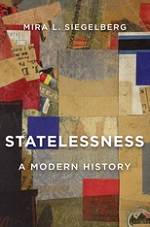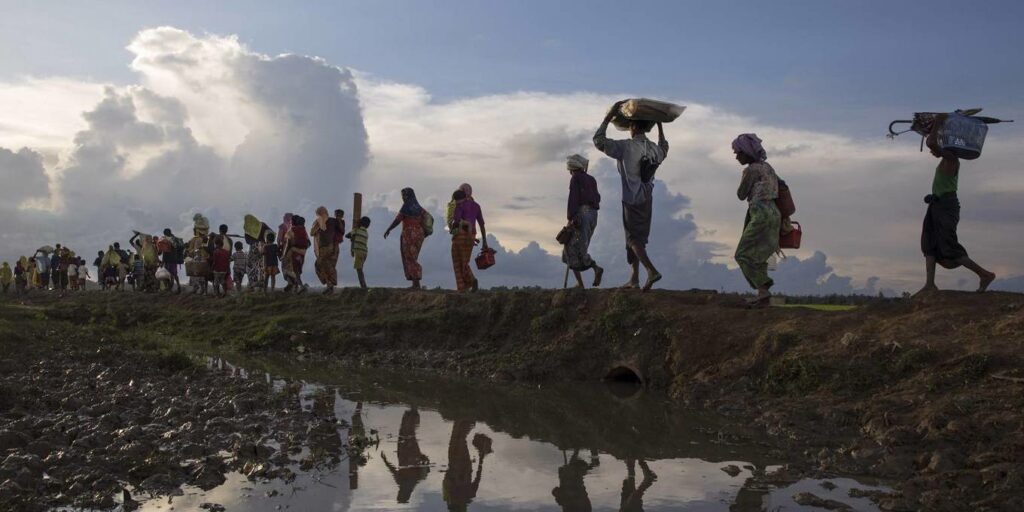The Statelessness Pandemic
REVIEWS, 18 Oct 2021
Laura van Waas and Natalie Brinham | Project Syndicate – TRANSCEND Media Service
Mira L. Siegelberg, Statelessness: A Modern History, Harvard University Press, 2020
Claire Zalc, Denaturalized: How Thousands Lost their Citizenship and Lives in Vichy France, Belknap Press, 2020
15 Oct 2021 – Over time, denaturalization has rightly come to be seen as a violation of human rights. But, as recent histories of the problem show, the international community still faces the same conundrum that it did a century ago, when droves of newly stateless people appealed to it for protection.
TILBURG – Legal theorists once consigned the idea of “statelessness” to the realm of fiction, because they considered it to be impossible within the state system that emerged after World War I. Every human being was supposed to be assigned a nationality and a country to call his or her own. But the war had created many refugees, and as empires disintegrated and new nation-states adopted exclusionary nationality laws, not everyone was in fact included.
The rise of fascism in the 1930s and 1940s further exposed the fallibility of this system and the ominous reality of the state’s power to exclude people or strip them of citizenship. Across Europe, citizenship-stripping went hand in hand with genocide for Jews and other minority groups.
Following World War II, questions about the right to nationality, state power, and the limits of sovereignty loomed large in the development of human rights and international law. Could the states that were being created out of the independence movements and diminished European empires adopt nationality laws that excluded entire population groups? Did national governments hold the power to strip their own citizens of that status? Who was responsible for the newly stateless?
These issues remain highly pertinent today. Statelessness affects at least 15 million people, and the nationality of millions more is under threat, owing to an escalation of racially discriminatory policies and rhetoric in many countries. Nationality policies remain a favored tool of authoritarians, who sometimes use them in tandem with mass atrocities, as in Myanmar, where the Rohingyas have been denied citizenship and subjected to genocide and mass deportations to Bangladesh. Making matters worse, the COVID-19 pandemic has led to even more xenophobic scapegoating and ethno-nationalism, with political leaders like former US President Donald Trump and Hungarian Prime Minister Viktor Orbán blaming migrants and refugees for spreading the coronavirus.
At least 15 million people today are stateless, and millions more are threatened with national exclusion. The issue of statelessness thus demands urgent attention, as do works of history that shed light on the problem.
The pandemic also reminds us of the enduring influence that nationality has over our lives. Last May, Filippo Grandi, the United Nations High Commissioner for Refugees, warned that, “The right to a nationality is a fundamental human right and in this time of crisis it can mean the difference between life or death.” When governments prioritize their citizens over others in their public-health and economic responses, the stateless suffer. Because statelessness remains a major blind spot for the institutions charged with protecting life and livelihoods, stateless people have been left further behind than ever.
Ghosts of Statelessness Past
At a time when statelessness demands urgent attention, two recent books provide important lessons about the nature of state power, international responses to national acts of exclusion, and the consequences of failure. Statelessness: A Modern History, by Mira L. Siegelberg of the University of Cambridge, and Denaturalized: How Thousands Lost Their Citizenship and Lives in Vichy France, by Claire Zalc, Director of the Institute of Modern and Contemporary History at the École Normale Supérieure, underscore both the historic scale of the problem and its grim costs. Each takes a different but equally meticulous approach to researching the history of the problem. And both explore how people have had their citizenship denied and revoked against the background of some of the most violent periods in modern history. Together, they remind us that the history of statelessness is a history of crumbling empires, world wars, genocides, and the emergence of an interstate system based on the formal equality of states.
Siegelberg’s work is a sweeping survey of international legal and political thought, covering a period that includes WWI, the rise of fascism in the 1930s, the Holocaust, the postwar reconstruction of the international legal order, and the independence movements of the postwar decades. Drawing on a wide variety of archival sources – including popular fiction, case law, correspondence from stateless people to the League of Nations, works of legal and political theory, and notes from negotiations on human-rights treaties – she documents how the problem of statelessness informed theories of human rights and sovereignty.

Siegelberg is concerned with how notions of statelessness developed within, and then shaped, “the political contours of the modern interstate order.” She reminds us that the concepts of citizenship and statelessness are not static. Rather, the meanings attached to these terms are constantly being reshaped and reconstructed by historic events and shifting power relations.
While Seigelberg’s book provides a comprehensive overview of international perspectives and experiences concerning statelessness and the modern state’s power to exclude, Zalc’s work focuses on Vichy France between 1940 and 1944, when Jews and others were denaturalized in increasing numbers to serve the Nazi agenda of deportation to death camps. Her detailed investigation provides unique insights into how bureaucracies in authoritarian regimes produce and reproduce violence.
Drawing on the Vichy government’s archives, Zalc follows the life stories of some of those who were naturalized as French during the interwar years, only to be stripped of their citizenship and deported under wartime France’s collaborationist regime. In parallel, she also delves into the life stories of the civil servants and judges who presided over these denaturalizations, revealing the murky boundaries between collusion and resistance to Nazi policies.
Creating the “Other”
Siegelberg’s Statelessness shows us that the racial hierarchies that characterized early twentieth-century citizenship regimes gave way not to equal citizenship, as was envisaged, but rather to other forms of racism in Europe. At the same time, Zalc’s book demonstrates how processes of citizenship were racialized with the help of seemingly neutral and innocuous bureaucratic categories and data collection. Under the French Third Republic, Jewishness had been considered a private matter of faith and thus went largely unrecorded by the state. But as Zalc shows in fascinating detail, the categorizations of “Jew” and “Israelite” were deciphered and applied retroactively to stigmatize and discriminate. With a new racialized definition of “Jew,” and under pressure from the occupying Nazi regime to identify, count, and denaturalize Jews according to quotas, individual citizen files were scrutinized for evidence of Jewishness.

This process relied on proxy indicators. Chief among these were first and last names which were deemed, sometimes inaccurately, “Jewish.” Name changes, too, were identified as suspicious. Other proxy indicators included place of origin, profession, and family affiliation. The lack of clarity on the criteria for denationalization, and the broad scope left for discretion in decision-making, enabled “bureaucratic anti-Semitism.”
Zalc’s work provides direct evidence of how state power – and sometimes state violence – functions through the routine processes of registration, categorization, and counting. This was how discriminatory decisions by administrators and judges, on the basis of predominantly unstated racial criteria, ultimately resulted in deportation and mass murder. Denationalization, Zalc shows, does not only result from explicit discrimination in nationality laws, but also from the misuse of administrative and bureaucratic processes.
We see this today, too. National registers or citizenship-verification processes requiring excessive documentation and paperwork are used to exclude and marginalize certain groups. A case in point is the mass disenfranchisement of Muslims carried out by Indian Prime Minister Narendra Modi’s government in Assam – the biggest exercise of its kind in this century. An administrative act described by the government as “just a process” has pushed some 1.9 million people to the brink of statelessness, and many more will follow if this “process” is rolled out nationwide.
Racialized categories are also still being applied retroactively to exclude people, including through proxy indicators such as name, place of origin, or one’s status as a “dual national.” For example, according to the Inter-American Commission on Human Rights, the denial and deprivation of nationality in the Dominican Republic has “disproportionately affected people of Haitian descent, who are frequently identified as such, correctly or incorrectly, based on the national origin or migratory status of their parents, skin color (especially those with a dark-colored skin), language ability, or surnames.”
And in Myanmar, where racial hierarchies in citizenship acquisition are explicit, registration and application processes have been fully weaponized against ethnic minorities and political opposition groups. Categories such as place of birth, religion, and family affiliation are used to single out Myanmar Muslims for discrimination. Meanwhile, Rohingyas using “Burmese names” on registration documents is forbidden, not explicitly in law but in the implementation of registration procedures at the township level. Local administrative processes, including restriction of movement for those within particular geographic pockets, enable the classification of ethnic and religious “others” and sustains systems of apartheid.
Under Cover of “National Security”
Siegelberg and Zalc highlight not only the potential for bureaucratic violence through the administration of citizenship, but also how this exercise of state power is put to deliberate and targeted use. The archival material examined by Zalc offers a sampling of some of the legitimizing rhetoric of the day. In Vichy France, the law on denationalization was “of primordial importance.” According to a 1941 letter by Prime Minister François Darlan, it was needed to ensure that “the morally tainted or insufficiently assimilated elements that have been allowed to infiltrate the national community be eliminated as soon as possible.”
Similarly, a recent academic symposium canvassing revocations of citizenship from the 1960s through the present (with contributions focusing on Syria, India, Nigeria, and Myanmar) identified a common thread: “those targeted for exclusion are reimagined and branded as ‘aliens’ or even ‘infiltrators,’ who the state can and must uncover.”
Zalc warns that the inherent “malleability of the notion of national interest” can easily be used to legitimize “discretionary power as being exercised in the name of the higher interests of the state.” This has become a live issue again today. The revocation of nationality is enjoying something of a renaissance even in some Western democracies, where it is framed as a counterterrorism measure. As the UN Special Rapporteur on contemporary forms of racism Tendayi Achiume noted in a 2018 report to the General Assembly:“
States all over the world continue to use national security and counterterrorism justifications to strip members of their national populations of citizenship […] which in practice [has] a disproportionate effect on marginalized racial, national, and religious groups.”
Turning a Blind Eye
When stateless people appealed to the League of Nations for assistance in the years following WWI, the world’s first global-governance body received so many letters that it was forced to acknowledge the issue, and to consider whether and how it could take up the refugees’ cause. But, as Siegelberg shows, the response was muted. Firm in their resolve to protect the legitimacy of states and the international state system, legal experts at the League shied away from “the messier world of politics.” They preferred to situate “the problem of statelessness within the domain of the conflict of laws and avoided addressing it as a wider international or humanitarian crisis resulting from mass denationalization or exclusionary national legislation.”
Then came the post-WWII system, which renewed the ambition to use international law to insulate the modern world against mass atrocities, statelessness, and human-rights abuses, but has proved insufficiently robust. States have maintained and adapted their powers to exclude and denationalize their own people.
This is evident even in countries that harbor no doubts about their status as liberal democracies. In 2019, the United Kingdom’s then-Home Secretary, Sajid Javid, summarily revoked the citizenship of Shamima Begum, a teenage girl who had run away from home to become the bride of an Islamic State fighter. (Since this decision had clear political motives and was taken without any judicial proceedings, a court of appeal ruled in July 2020 that Begum should be allowed to return to the UK to fight the decision, but this ruling was overturned by the UK Supreme Court.)
Siegelberg probes the sources of the current international system’s weaknesses, such as the relationship between human-rights frameworks and sovereignty. In recent decades, important strides have been made in reframing statelessness as a human-rights issue, rather than as merely a matter of conflicting laws. Solutions have shifted from a focus on technical legal assistance (which tiptoes around the elephant in the room – state power) to approaches that challenge discrimination and states’ exclusionary powers directly.
And yet, the international system still renders us powerless to temper the discretionary power of states to choose their own membership. There is no reliable, effective check against authoritarian states that set out to disenfranchise sections of their national communities.
The contemporary drivers of statelessness are eerily reminiscent of the League of Nations era. Ethno-nationalism, security-related anxiety, and economic scapegoating are all contributing to processes of “Othering” that, in the extreme, leave individuals or entire communities without citizenship. And, as was true of the post-WWI period, we have very few effective remedies to protect stateless people.
At the same time, statelessness remains a key causal factor in human-rights abuses. The international community has come under scrutiny for failing to protect Myanmar’s Rohingyas from mass atrocities. But the writing there had been on the wall since the enactment of the country’s 1982 citizenship law, which stripped them of their rights.
Willful ignorance of the problem of statelessness has provided fertile ground for official abuses historically. Today, we must not look away as xenophobia is institutionalized in citizenship laws and bureaucracies. We must put aside fears of the “messier world of politics” and call states to account for their exclusions – before it is too late for the excluded.
______________________________________________
 Natalie Brinham is an Economic and Social Research Council (ESRC) PhD student at Queen Mary University of London researching statelessness and state crime and a member of the TRANSCEND Network for Peace Development Environment. She has worked for many years in NGOs in the UK and Southeast Asia on forced migration, trafficking and statelessness in both front-line service provision roles and research and advocacy roles. This included four years working as a research and advocacy consultant on a multi-country project on the human rights of stateless Rohingya. Under the pseudonym Alice Cowley, she co-authored a three-year study on the Slow-Burning Genocide of Myanmar’s Rohingya with Maung Zarni. She holds an MA from UCL Institute of Education and a BA (Honors) from the School of Oriental and African Studies. natalie.brinham@gmail.com
Natalie Brinham is an Economic and Social Research Council (ESRC) PhD student at Queen Mary University of London researching statelessness and state crime and a member of the TRANSCEND Network for Peace Development Environment. She has worked for many years in NGOs in the UK and Southeast Asia on forced migration, trafficking and statelessness in both front-line service provision roles and research and advocacy roles. This included four years working as a research and advocacy consultant on a multi-country project on the human rights of stateless Rohingya. Under the pseudonym Alice Cowley, she co-authored a three-year study on the Slow-Burning Genocide of Myanmar’s Rohingya with Maung Zarni. She holds an MA from UCL Institute of Education and a BA (Honors) from the School of Oriental and African Studies. natalie.brinham@gmail.com
 Laura van Waas, Assistant Professor of International Law at Tilburg Law School in the Netherlands, is a founder and Co-Director of the Institute on Statelessness and Inclusion.
Laura van Waas, Assistant Professor of International Law at Tilburg Law School in the Netherlands, is a founder and Co-Director of the Institute on Statelessness and Inclusion.
Tags: Burma/Myanmar, Citizen Rights, Human Rights, Institute on Statelessness and Inclusion, Reviews, Rohingya, Statelessness
DISCLAIMER: The statements, views and opinions expressed in pieces republished here are solely those of the authors and do not necessarily represent those of TMS. In accordance with title 17 U.S.C. section 107, this material is distributed without profit to those who have expressed a prior interest in receiving the included information for research and educational purposes. TMS has no affiliation whatsoever with the originator of this article nor is TMS endorsed or sponsored by the originator. “GO TO ORIGINAL” links are provided as a convenience to our readers and allow for verification of authenticity. However, as originating pages are often updated by their originating host sites, the versions posted may not match the versions our readers view when clicking the “GO TO ORIGINAL” links. This site contains copyrighted material the use of which has not always been specifically authorized by the copyright owner. We are making such material available in our efforts to advance understanding of environmental, political, human rights, economic, democracy, scientific, and social justice issues, etc. We believe this constitutes a ‘fair use’ of any such copyrighted material as provided for in section 107 of the US Copyright Law. In accordance with Title 17 U.S.C. Section 107, the material on this site is distributed without profit to those who have expressed a prior interest in receiving the included information for research and educational purposes. For more information go to: http://www.law.cornell.edu/uscode/17/107.shtml. If you wish to use copyrighted material from this site for purposes of your own that go beyond ‘fair use’, you must obtain permission from the copyright owner.
